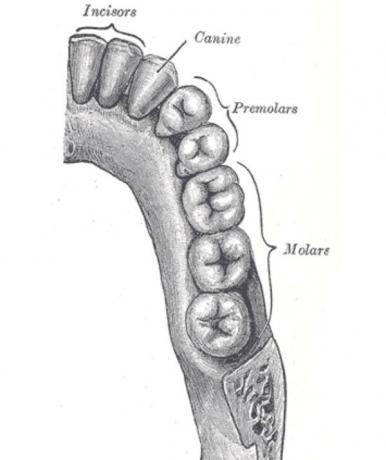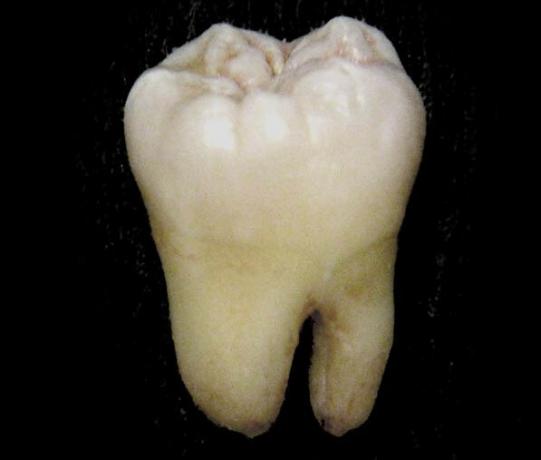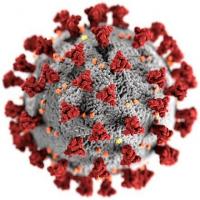The 4 types of human teeth
Facial anatomy is essential for the human being, not only to speak, but to gesture and project a concrete vision of ourselves to the outside.
According to professional sources, more than 65% of communication in our species is non-verbal, that is, we rely on gestures, tones and contexts to convey what we want to say as succinctly as possible, regardless of what our words.
The facial musculature is essential for communication between two people, but beyond it, the teeth also play a vital role. Oral hygiene is indicative of personal self-care, discipline, and, to some extent, financial status and sexual suggestion. A smile with aligned teeth creates facial harmony and gives a feeling of stability, neatness, and symmetry, among many other things.
Beyond aesthetics, teeth are essential to grind food and form the bolus, prevent it from escaping through the mouth, to support the tongue in the formation of sounds and many things more. If you want to know the types of teeth and their functionality in humans, keep reading.
- Related article: "The 3 parts of the mouth (and their functions)"
What are the types of teeth in humans?
The tooth, from a physiological point of view, is defined as a hard and white anatomical organ that grows, together with other structures, in the mouth of humans and other vertebrates. Its main function is to cut and chew food, although in some taxa they are also used some teeth as a method of defense and attack (especially felids and caniforms, hence the size of their canines).
Normally, when we go to the classification of teeth, we turn directly to the structures present in the mouth of adults. In this case, we will make a special mention in the first instance to the deciduous dentition, to then go through the permanent teeth and their functionality, both speech and digestive.
1. Deciduous dentition
The deciduous dentition or "milk teeth" refers to the first set of teeth that appears during the ontogeny of humans and other mammals.. The first to appear are the lower central incisors (6-9 months), then the rest of the incisors (10 months) and, from there, the first canines and molars (15-21 months). The last teeth to emerge are the second molars, 24 months after birth.
Once all the temporary structures appear, the infant has 20 total teeth, 10 in the upper arch and 10 in the lower one (4 incisors + 2 canines + 4 molars). The crown and root of these dental structures is much weaker than those present in permanent dentition, and in addition, the enamel and dentin layers are less thick. The mineral composition is also lower, hence its color is milky-white, unlike the normal yellowish tone.
The correct growth of the deciduous dentition it is essential for proper oral hygiene in adulthood. Among all the functions of milk teeth, we can highlight the following:
- They serve as a guide to eruption: baby teeth mark the path of the appearance of permanent ones. In addition, as their loss is gradual, errors can be detected and tried to correct them before the permanent dentition has been fully established.
- Digestion and assimilation: they allow the consumption of solid foods in the moments of maximum development.
- Stimulation: thanks to the chewing process with the deciduous dentition, the synthesis and emergence of the missing permanent teeth is stimulated.
- Phonation: the tongue is supported by the incisor teeth (“paddles”) to produce certain sounds. These are called "dental consonants."
The posterior deciduous molars are generally the last to fall, between 10 and 12 years of age.. From the age of 13, the human being presents the complete dentition that will accompany him for the rest of his life.
- You may be interested in: "Bacteria that live in the mouth: characteristics, types and functions"
2. Permanent dentition
Unlike the previous case, the permanent dentition consists of 32 teeth, 16 in each arch (4 incisors + 2 canines + 4 premolars + 6 molars X 2). You must take into account that, in turn, each arch is divided by two if we take into account the excision of the sagittal plane (the face composed of two halves).
The permanent dentition has a thick layer of tooth enamel, made up of hydroxyapatite and proteins. Surprisingly enough, this biological makeup gives rise to the most resistant biological tissue in the entire human body and in the entire world, at least in nature. Beyond enamel, various structures are distinguished, such as dentin, root cement, dental pulp, and periodontium.
Then, we briefly review each of the types of permanent teeth, although we will not only look at its chewing function.
2.1 Incisors
As we have said, there are a total of 8 teeth (4 up and 4 down), which make up the front section of the mouth and the main component of the smile. They have a sharp edge, since their main component is cutting the food. If we see the functionality of each tooth with a maximum of 100% in all their work together, we will see that the incisors have 10% chewing work and 90% phonator / esthetic.
Without any doubt, the lack of an upper incisor is an aesthetic characteristic that completely breaks the harmony. facial, and therefore fillings, veneers and false teeth are always used (depending on the severity of the injury) to replace it. Also, as we have said, dental consonants are formed thanks to the incisors and the tongue in conjunction, such as / t /, / d /, / n /, and / l /.

2.2 Canines
The canines are a total of 4 teeth, 2 in the upper dental arch and 2 in the lower one (one on each side of the sagittal plane), whose main function is to tear food.
Due to its role in chopping meat and other hard foods, it is easy for us to imagine why carnivorous animals have such developed canines (fangs). Its shape is pointed cusp, with a large coronal and root size. 20% of their work is chewing and 80% phonetic and aesthetic.

- You may be interested in: "The 5 types of meat, their properties and disadvantages"
2.3 Premolars
8 teeth (4 in each dental arch), with a total surface area wider than that of the canines and two pointed cusps. They are generally designated as bicuspid tooth structures, although the second lower premolar has 3 cusps.
Its main function is to grind food and allow it to mix with saliva, since it contains enzymes (such as α-amylase) responsible for starting the digestion process. The function of the premolars is 60% masticatory, although they also present 40% phonatory work, since they participate in the creation of the "alveolar consonants".

2.4 Molars
The thickness of the dental apparatus of the human being. The molars are a total of 12 teeth, 6 in each dental arch and 3 in each sagittal plane (3x4 = 12). Their function is the same as that of the premolars, but these pieces have 4 to 5 prominences on their surface. The main task of the molars is to disintegrate the food as much as possible so that the food bolus is easy to digest in the stomach region. Its function is almost 100% chewing.
Interestingly, the human being seems to be undergoing a clear food transition that has been taking place for hundreds of years. Because we no longer consume plant matter with a high content of cellulose and other difficult-to-digest compounds, certain parts of our gastrointestinal tract have shortened, giving rise to structures such as the vermiform appendix. This is also reflected in the tooth shape, and therefore many people lack third molars.

This phenomenon is known as dental agenesis or anodontia. It is estimated that approximately 25% of the world's population lacks wisdom teeth, these structures that tend to report more problems than benefits once they begin to emerge in the environment of the gum. If these pieces are really useless or harmful today, it can be speculated that in the future the human species will have completely disposed of them.
Resume
If we want you to keep a central idea, this is the following: the deciduous dental apparatus is composed of 20 teeth, while the permanent one has 32 (8 incisors, 4 canines, 8 premolars and 12 molars). While the incisors have an eminently phonatory and aesthetic function, the molars are responsible for disintegrating the food almost 100%. Each type of tooth has a different functionality, but all are complementary and base their work on two fronts: allowing speech and food processing.


